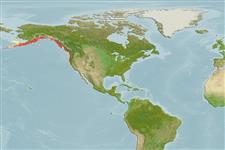>
Osmeriformes (Freshwater smelts) >
Osmeridae (Smelts)
Etymology: thaleichthys: thaleichthys meaning rich fish - referring to a high oil content (Ref. 1998).
More on author: Ayres.
Environment: milieu / climate zone / depth range / distribution range
ນິເວດວິທະຍາ
ສັດທະເລ; ນ້ຳຈືດ; ນ້ຳກ່ອຍ ກ່ຽວກັບ (ຢູ່)ເທິງຊັ້ນພື້ນດິນໃນທະເລເປີດ; ປາທີ່ມີການເຄື່ອນຍ້າຍຈາກທະເລ ແລະ ໄປໄຂ່ຢູ່ນ້ຳຈືດ (Ref. 51243); ລະດັບຄວາມເລິກ ? - 137 m (Ref. 6885). Temperate; 61°N - 38°N (Ref. 26213)
North Pacific: Prince William Sound, Alaska to Monterey Bay, California, USA. Landlocked in Washington and Union Lakes in Washington, USA.
Length at first maturity / ຂະໜາດ / ນ້ຳໜັກ / Age
Maturity: Lm 9.0 range ? - ? cm
Max length : 20.0 cm TL ຕົວຜູ້/ບໍ່ມີເພດ; (Ref. 27547); common length : 15.0 cm NG ຕົວຜູ້/ບໍ່ມີເພດ; (Ref. 27547); ອາຍຸສູງສຸດທີ່ເຄຍລາຍງານມາ: 3.00 ປີ (Ref. 12193)
ຄີ (ໜາມ)ແຂງຢູ່ຫຼັງປາ (ທັງໝົດ) : 0; ຄີຫຼັງຂອງປາ (ຄີອ່ອນ) (ທັງໝົດ) : 8 - 10; ຄີ(ໜາມ) ແຂງຢູ່ຄີກົ້ນປາ
ກຸ່ມປາກະດູກແຂງ
ຄວາມຖີ່ຂອງກຸ່ມຖ່າຍທອດພັນ
ປາທີ່ມີການເຄື່ອນຍ້າຍຈາກທະເລໄປຫານ້ຳຈືດ ແລະນ້ຳຈືດຫາທະເລ
ປາທີ່ມີການເຄື່ອນຍ້າຍຈາກທະເລແລະໄປໄຂ່ຢູ່ນ້ຳຈືດ
ຄີກົ້ນຂອງປາ
ສັດທີ່ມີກະດູກສັນຫັຼງ
ການຖ່າຍທອດທາງກຳມະພັນຈາກພໍ່ແມ່ຫາລູກ: 0; ຄີກົ້ນຂອງປາ: 15 - 19; ສັດທີ່ມີກະດູກສັນຫຼັງ: 55 - 61. Distinguished by its long upper jaw, which reaches at least below the middle of the eye in adults; the fine teeth in a single row on the vomer and palatine bones; and the 38 to 47 gill rakers on the 1st arch (Ref. 27547). Gill rakers long; lateral line incomplete and reaching not quite to below dorsal fin (Ref. 27547). Breeding males have tubercles on upper sides of paired fins (Ref. 27547). Pale olive brown dorsally, silvery white on sides and ventral surfaces; fins usually stripped along the rays, but inter-ray membranes clear;. Young are translucent with 2 rows of large black spots, on each side of the midline of the back, from head to caudal peduncle; peritoneum silver with light speckling. Spawning males with moss-green backs, and dense, black speckling on the head and dorsal surface of the body. The peritoneum is silvery with black speckling.
Found close to shore, in bays and estuaries and ascends coastal streams to spawn (Ref. 5723). There are landlocked populations (Ref. 5723) but these do not reach as great a size as sea-run fish (Ref. 27547). Anadromous (Ref. 96339). Individuals found in brackish and salt water feed on small crustaceans (Ref. 1998). Fish from the sea are reported to have good flavor, but supply is limited (Ref. 6885). Often abundant during the spawning run, but flesh reported to be soft and oily, easily spoiling (Ref. 1998).
Although most individuals die after spawning, some females apparently survive to age 3. It is not known whether or not these 3-year-olds spawned previously (Ref. 27547).
Page, L.M. and B.M. Burr, 1991. A field guide to freshwater fishes of North America north of Mexico. Houghton Mifflin Company, Boston. 432 p. (Ref. 5723)
IUCN Red List Status (Ref. 130435: Version 2024-1)
Threat to humans
Harmless
Human uses
ການປະມົງ: ການປະມົງແບບກຸ້ມຕົນເອງ
ເຄື່ອງມື
Special reports
Download XML
ແຫຼ່ງອີນເຕີເນັດ
Estimates based on models
Preferred temperature (Ref.
123201): 4.4 - 11.6, mean 8.4 °C (based on 196 cells).
Phylogenetic diversity index (Ref.
82804): PD
50 = 0.6250 [Uniqueness, from 0.5 = low to 2.0 = high].
Bayesian length-weight: a=0.00372 (0.00178 - 0.00775), b=3.17 (2.99 - 3.35), in cm total length, based on LWR estimates for this (Sub)family-body shape (Ref.
93245).
ຊັ້ນເຂດຮ້ອນ (Ref.
69278): 3.2 ±0.35 se; based on food items.
Generation time: 2.6 ( na - na) years. Estimated as median ln(3)/K based on 1
growth studies.
ຄວາມຢືດຢຸ່ນ (Ref.
120179): ຂະໜາດກາງ, ປະຊາກອນຕຳ່ສຸດທີ່ໃຊ້ເວລາສອງເທົ່າ 1.4 - 4.4 ປີ (tm=2; tmax=3; K=0.43; Fec=535).
Fishing Vulnerability (Ref.
59153): Low to moderate vulnerability (28 of 100).
